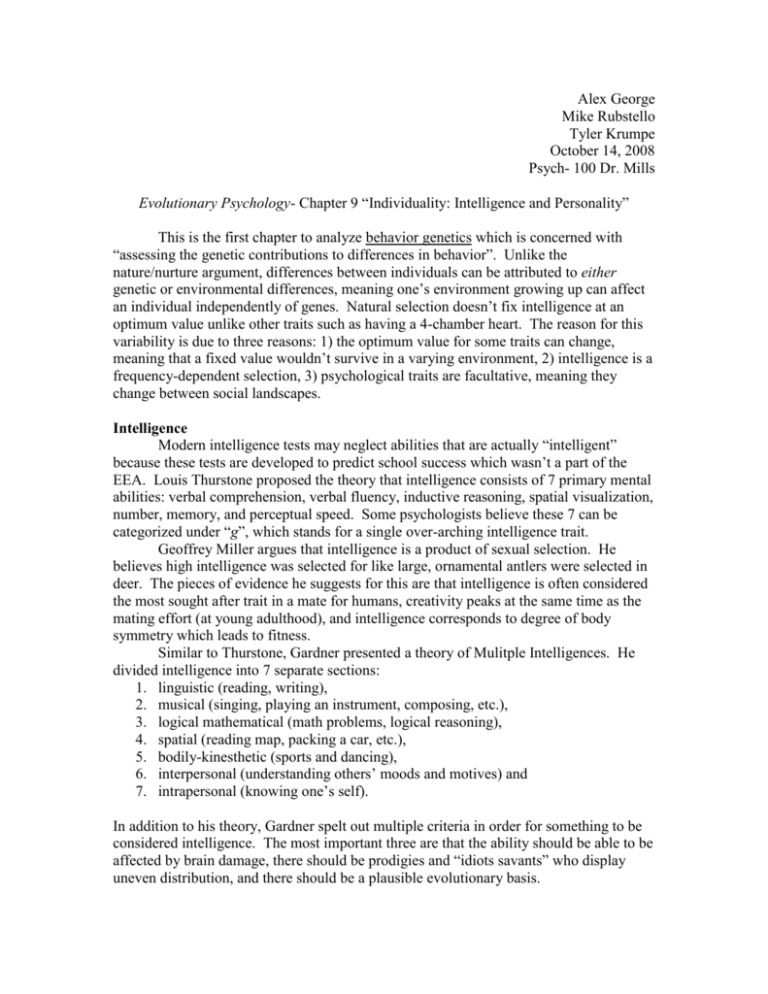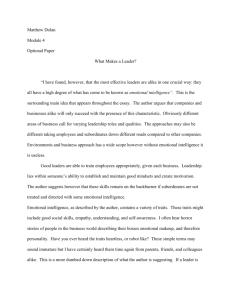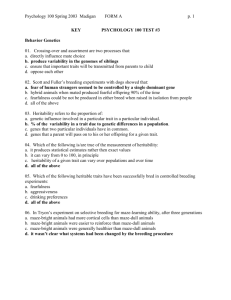Psych Ch. 9 summary edited
advertisement

Alex George Mike Rubstello Tyler Krumpe October 14, 2008 Psych- 100 Dr. Mills Evolutionary Psychology- Chapter 9 “Individuality: Intelligence and Personality” This is the first chapter to analyze behavior genetics which is concerned with “assessing the genetic contributions to differences in behavior”. Unlike the nature/nurture argument, differences between individuals can be attributed to either genetic or environmental differences, meaning one’s environment growing up can affect an individual independently of genes. Natural selection doesn’t fix intelligence at an optimum value unlike other traits such as having a 4-chamber heart. The reason for this variability is due to three reasons: 1) the optimum value for some traits can change, meaning that a fixed value wouldn’t survive in a varying environment, 2) intelligence is a frequency-dependent selection, 3) psychological traits are facultative, meaning they change between social landscapes. Intelligence Modern intelligence tests may neglect abilities that are actually “intelligent” because these tests are developed to predict school success which wasn’t a part of the EEA. Louis Thurstone proposed the theory that intelligence consists of 7 primary mental abilities: verbal comprehension, verbal fluency, inductive reasoning, spatial visualization, number, memory, and perceptual speed. Some psychologists believe these 7 can be categorized under “g”, which stands for a single over-arching intelligence trait. Geoffrey Miller argues that intelligence is a product of sexual selection. He believes high intelligence was selected for like large, ornamental antlers were selected in deer. The pieces of evidence he suggests for this are that intelligence is often considered the most sought after trait in a mate for humans, creativity peaks at the same time as the mating effort (at young adulthood), and intelligence corresponds to degree of body symmetry which leads to fitness. Similar to Thurstone, Gardner presented a theory of Mulitple Intelligences. He divided intelligence into 7 separate sections: 1. linguistic (reading, writing), 2. musical (singing, playing an instrument, composing, etc.), 3. logical mathematical (math problems, logical reasoning), 4. spatial (reading map, packing a car, etc.), 5. bodily-kinesthetic (sports and dancing), 6. interpersonal (understanding others’ moods and motives) and 7. intrapersonal (knowing one’s self). In addition to his theory, Gardner spelt out multiple criteria in order for something to be considered intelligence. The most important three are that the ability should be able to be affected by brain damage, there should be prodigies and “idiots savants” who display uneven distribution, and there should be a plausible evolutionary basis. The difference in intelligence among individuals follows a bell curve because it is due to genes (it’s a polygenic trait, like skin color), it’s dependent on one’s sociality while growing up, and sexual selection demands for variability. Personality Personality is very similar to intelligence in that the reasons for variability among individuals are the same. It is how we represent our style of interacting with others and confronting challenges and opportunities. Because personality traits are based on how people perceive each other, it is hard to define the personality of a particular person. The most basic way to assess a personality was to ask people to describe others. The text refers to the Big Five Personality Traits as: 1. Openness to experience/ Intelligence a. Curious and creative b. An open person will make wise decisions and give good advice. 2. Conscientiousness a. Organized and hard-working b. This shows who will complete tasks and who will not 3. Extraversion a. Bold, active, talkative b. This shows who is likely to become powerful or high in status. 4. Agreeableness a. Trusting and helpful b. This shows who will be the better cooperator, and who can be trusted. 5. Neuroticism a. Worrying, nervousness b. This shows who will handle stress better. Buss suggested that these five personality traits represent adaptations to particular problems people faced socially. Differences in personality come from the fact that the best combination of traits could vary from time to time, frequency dependent selection, and facultative adaptations. The best combination could vary from time to time because environment changes could favor one trait over another in one generation, but the opposite one in the next. Frequency dependent selection is when there is a lot of one trait, like extraverts, then introverts may succeed more by staying out of conflict. When there are more introverts, the extraverts may succeed by standing out more than the introverts. Some personality traits are also facultative, meaning that evolution has already crafted a particular norm of reaction. Edited by: Ting-Tien Wee Chase Platon






